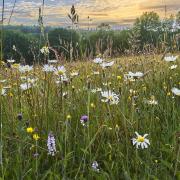Volunteers are the key to restoring a historic transport link and creating future tourism prosperity

Thames and Severn Canal and Stroudwater Navigation (collectively known as the Cotswold Canals) once linked the Thames, through the Cotswold Hills, to the River Severn and were key to the growth of industry and prosperity at the height of their use in the 19th century.
In 1927, the Thames and Severn Canal was formally abandoned from Lechlade to Whitehall. This was followed by abandonment of the remaining length in 1933. The Stroudwater Navigation, which had remained independent, was used until 1941, when traffic effectively ceased. It was closed by Act of Parliament in 1954, despite vigorous lobbying to keep it open.
Whilst once key for industry, the Cotswold Canals are now a picturesque walking and cycling route and an important part of the local landscape. They are a haven for flora and fauna with the stretches still in water a thriving aquatic habitat. In addition, they offer a unique insight into the industrial heritage of the area with interesting features peppered along the 37 miles.
These iconic landmarks are now returning to life as restoration activity increases: 2015 marks a new threshold in the long-term aim to restore both canals. The predecessor to the present Cotswold Canals Trust was formed in 1972. Over the years, the Trust has flourished and is now the largest, canal restoration society in the country. The Trust’s success can easily be measured by the large number of enthusiastic volunteers who restore locks, staff visitor centres, run trip boats, dredge the waterways, and so on. In 2002, the Trust joined other committed organisations to form the Cotswold Canals Partnership, which has seen the pace of restoration increase rapidly since 2008, with Stroud District Council taking a lead role.

The task of restoring the canals is broken down into three phases. Phase 1 (split into 1A and 1B) stretches from Saul Junction on the Gloucester –Sharpness Canal to Brimscombe. Phase 2 is the eastern end, from Lechlade to Cerney Wick. Phase 3 is the section over the Cotswolds.
Stroud District Council is the lead partner in delivering Phase 1A, from Stonehouse to Hope Mill, which has been supported by a large Heritage Lottery Fund Grant and is due to be completed later this year. This phase will restore six miles of canal, 10 locks and nine bridges.
The next Phase (1B) is set to bring Stroud, Stonehouse, Eastington and Whitminster within navigable reach of Britain’s 2,500-mile network of waterways once again. This will create the missing link between the nearly restored section of canal from Stroud to Stonehouse and the junction with the Gloucester-Sharpness Canal at Saul Junction. This will cost a total of £20 million, including £5 million of ‘match’ funds won through a dedicated fundraising campaign targeting corporate and individual donations, and over £2 million-worth of volunteer effort. The bid will be submitted in November this year.
There is quiet confidence that by 2020, Stroud, Stonehouse, Eastington and Whitminster will once again become canal-side communities, with boats and other visitors bringing a vibrant and colourful new life – alongside many other benefits already being enjoyed by towns and cities in Britain that have seen their watersides reborn.

This is where volunteers from the Cotswold Canals Trusts and other restoration groups. Without the concerted volunteer effort on the Cotswold Canals, restoration progress would be much slower and more costly.
The Inland Waterways Association’s Waterway Recovery Group (WRG) supports Cotswold Canals Trust’s restoration efforts by holding a selection of its week long working holidays, called ‘Canal Camps’, on the Trust’s sites. WRG ‘Canal Camps’ offer a unique opportunity to volunteer and learn new skills, whilst exploring amazing parts of Britain’s industrial heritage. Each camp costs £56 and is open to anyone aged over 18. In 2014, WRG spent 40,000 volunteer hours working towards the restoration of derelict waterways and we want to do even more in 2015!
Over Easter, more than 40 WRG volunteers spent two weeks brick-laying at Bowbridge Lock on the Cotswold Canals, making significant progress. Further work from Trust and WRG volunteers means that the lock is ready for the coping stones to be relayed and is nearing completion. Further work along the Stroudwater Navigation has reinstated towpaths and advanced improvements to the canal and its settings.

Waterway Recovery Group Cotswold Canals Canal Camp Dates:
WRG has six Canal Camps planned on the Cotswold Canals this summer, which will see over 110 volunteers spending a week progressing the Cotswold Canals Trust’s plans.
There are still spaces on camps running from 8th – 15th August and 15th – 22nd August. If you are interested in volunteering on a WRG Canal Camp this year, a full list of dates can be found on the WRG website or email enquiries@wrg.org.uk to request a Canal Camps brochure. To book on a Canal Camp visit the WRG website www.wrg.org.uk or call WRG Head Office on 01494 783 453 ext 604.

Volunteer with Cotswold Canal Trust
There are also opportunities for day volunteering with Cotswold Canals Trust. To find out more visit the Trust’s website at www.cotswoldcanals.com/pages/become-a-volunteer.php
Get involved and help bring these vibrant, beautiful canals back to life.



























